Adjusting the temperature on a mini fridge without numbers can be challenging for many users.
Without a temperature dial with specific numbers, it can be challenging to set the temperature to the right level.
We will discuss here how to adjust the temperature on a mini fridge without numbers in a step-by-step guide.
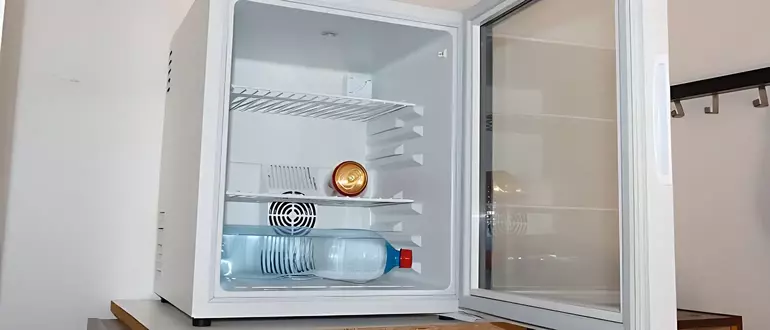
How to Adjust the Temperature on a Mini Fridge without Numbers
If you have a mini fridge without temperature numbers, you can still adjust to your desired temperature with these simple steps.
Step 1: Locate the Temperature Dial
The temperature dial on a mini fridge without numbers may look different from those with numbers.
It can be a dial or a slider that indicates only cold and warm or low and high.
The temperature dial is located inside the fridge, near the back wall, or on the side. Look for a small knob or slider that can be moved to adjust the temperature.
Step 2: Set the Dial to the Middle Position
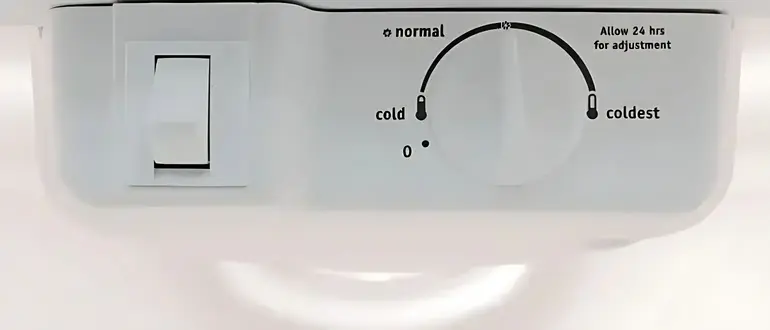
Before adjusting the temperature on a mini fridge, it’s crucial to set the dial to the middle position. This will ensure coldness or warmth. Turn it to the middle position.
Step 3: Monitor the Temperature
After setting the dial to the middle position, wait for at least an hour before checking the temperature.
This will give the fridge time to adjust to the new setting. Use a thermometer to check the temperature inside and adjust the dial accordingly.
Step 4: Adjust the Temperature
If the temperature is too high, turn the dial towards the colder setting. If the temperature is too low, turn the dial towards the warmer setting.
Wait for at least an hour before checking the temperature again. Repeat the process until the temperature is fixed.
Step 5: Maintain the Temperature
After achieving the desired temperature maintain it. Keep an eye on the temperature and adjust the dial as needed.
The fridge should not be overstocked to affect the temperature inside the fridge.
Common Problems with Mini Fridge Temperature Dial and their Solutions
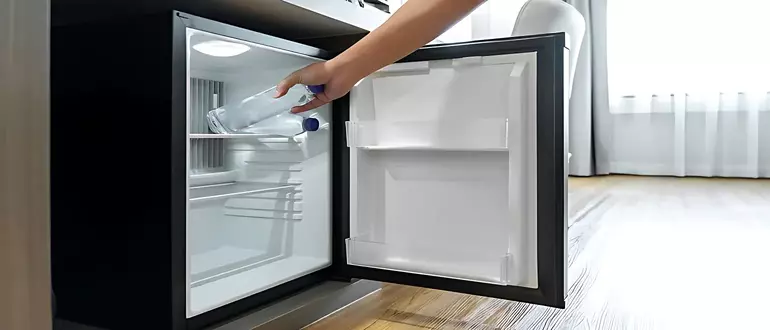
Temperature problems with mini-fridges can be frustrating, but luckily there are some easy solutions to common issues.
Mini Fridge Not Cooling Enough
If your mini fridge is not cooling enough, it could be due to several reasons. The temperature dial should be set to the right temperature.
It can cause the fridge to freeze up due to high temperatures. If it’s set too low, it won’t be able to cool enough.
Another reason could be a dirty condenser coil. Remove the plug from the fridge and clean the coil with a brush or vacuum.
Mini Fridge Too Cold
If your mini fridge is too cold, it can cause your food and drinks to freeze, making them unfit for consumption.
One reason for this could be that the temperature dial is set too low. Adjust the dial to a warmer temperature and check if it solves the problem.
Another reason could be a faulty thermostat. In this case, it’s best to call a professional to replace it.
Mini Fridge Making Strange Noises
If your mini fridge is making strange noises like humming, buzzing, or rattling, it could be due to several reasons. One reason could be that the fridge is not level.
Try adjusting the fridge’s feet to level it. Another reason could be a faulty compressor or fan. Call a professional to repair it.
Mini Fridge Door Not Closing Properly
If your mini fridge door is not closing properly, it can cause warm air to enter the fridge, making it difficult for the fridge to cool properly.
One reason for this could be that the gasket is dirty or damaged.
Clean the gasket with warm, soapy water and check if it solves the problem. If the gasket is damaged, it’s best to replace it.
Mini Fridge Freezing Food in the Refrigerator Compartment
If your mini fridge is freezing food in the refrigerator compartment, it could be due to several reasons. One reason could be that the temperature dial is set too low.
Adjust the dial to a warmer temperature and check if it solves the problem. Another reason could be a blocked air vent.
Remove any items that are blocking the vent and check if it solves the problem.
Troubleshooting Mini Fridge Temperature Control Issues
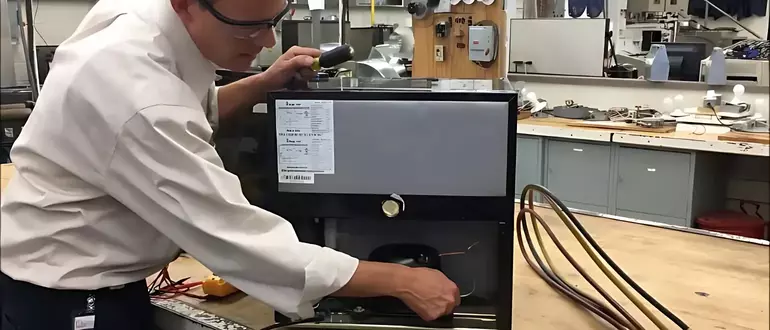
Here are some troubleshooting tips to help you fix common mini fridge temperature control problems:
Check the temperature dial
The temperature dial is the primary control for regulating the temperature.
Check the dial first to make sure it’s set to the correct temperature. Most mini-fridges have a temperature range of 35-40 degrees Fahrenheit.
Clean the condenser coils
If the temperature dial is set correctly but the fridge is still not cooling properly, the problem may be with the condenser coils.
These coils can become dirty and clogged, which can prevent proper cooling. Use a vacuum or brush to remove any dust or debris.
Defrost the fridge
Too cold temperatures can cause food to freeze and even damage the fridge.
Try defrosting the fridge by unplugging it and leaving the door open for a few hours.
Plug the fridge back in and set the temperature dial to the correct temperature.
Check the thermostat
If the temperature dial is set correctly and the condenser coils are clean, the problem may be with the thermostat.
The thermostat is responsible for regulating the temperature and the fridge will not cool properly. Use a multimeter to check for continuity.
Inspect the thermistor
The thermistor is another component that can cause temperature control issues in mini-fridges.
This sensor detects the temperature inside the fridge and sends a signal to the thermostat.
A faulty thermistor can cause the fridge to cool too much or not enough. Use a multimeter to check the resistance.
Tips for Precise Temperature Control in Mini Fridges
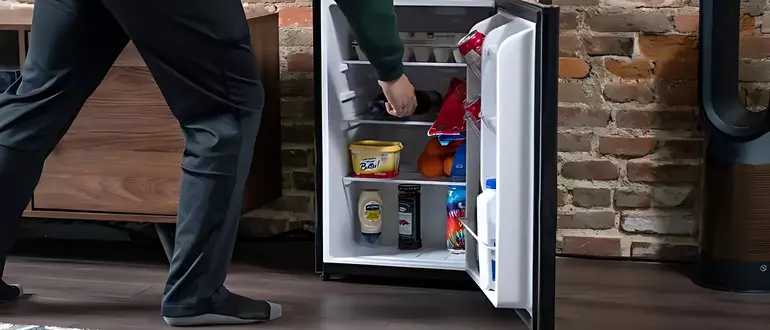
Here are some tips for achieving precise temperature control in your mini–fridge:
Choose the right location:
The location of your mini fridge can affect its temperature control. Make sure to place it in a spot away from direct sunlight or heat sources like radiators or ovens.
This will help your mini fridge maintain a stable temperature and prevent it from fluctuating.
Use a thermometer:
Using a thermometer is one of the best ways. Place a thermometer inside your fridge to monitor the temperature and adjust it.
This will help you avoid the guesswork and prevent your food from spoiling.
Set the temperature to the right level:
Mini fridges have different temperature settings, so it’s essential to know the ideal temperature for the items you’re storing.
For example, a temperature range of 33 to 40 degrees Fahrenheit is ideal for perishable foods such as dairy products, meat, and eggs.
Keep the fridge organized:
A well-organized mini fridge makes it easier to maintain a consistent temperature. Store your food items properly.
Making sure there’s enough space for air to circulate. This will help keep the temperature constant and prevent the fridge from overworking.
Keep the door closed:
This may seem obvious, but leaving the door of your mini fridge open for too long can affect its temperature control.
Make sure to keep the door closed and do not open it unnecessarily. This will help your mini fridge maintain a consistent temperature and save energy.
Clean the fridge regularly:
A dirty fridge can affect its temperature control and cause it to work harder than necessary.
Make sure to clean your mini fridge regularly, wiping down the shelves and removing any expired food items.
This will help keep the temperature consistent and prevent odors from developing.
FAQs
How Long Should I Wait After Adjusting The Temperature To See If It’s Working?
Wait for a few hours after adjusting the temperature to allow the temperature to stabilize. Avoid opening the fridge door during this time, as this can cause fluctuations in temperature.
What Should I Do If The Temperature Still Isn’t Right After Adjusting It?
Try adjusting the temperature over a few days until you reach the desired temperature, there can be an issue with the thermostat or the cooling system, and you need to fix it.
What Should I Do If My Mini Fridge Doesn’t Have A Temperature Control Knob Or Switch?
If your mini fridge doesn’t have a temperature control knob or switch, you need to contact the manufacturer or professional repair service for assistance. Some models may have a hidden temperature control setting that requires a specific button sequence to access.
Can I Use A Smartphone App To Control The Temperature Of My Mini Fridge?
Some newer models of mini fridges may come with a smartphone app that allows you to control the temperature remotely. Check the user manual or contact the manufacturer if there is any option.
Conclusion
While adjusting the temperature on a mini fridge without temperature numbers may present some challenges, it is still possible to achieve accurate temperature control.
By employing manual adjustment methods, monitoring the temperature with a thermometer, and seeking professional assistance when necessary, you can ensure that your food and beverages are stored at the appropriate temperature.
It is important to regularly check and adjust the temperature as needed to ensure optimal functioning of your mini fridge.
